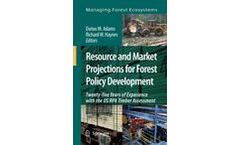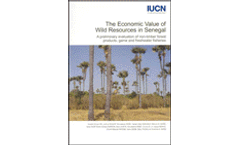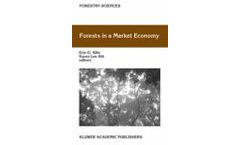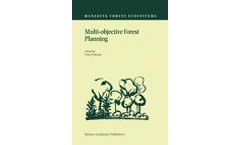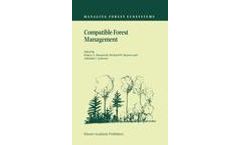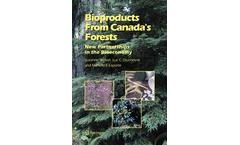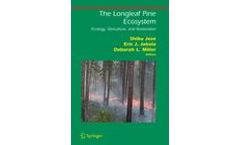Refine by
forest-production books
17 books found
This volume comprises fifteen papers exploring the consequences of applying modern time-series methods, particularly co-integrated time-series methods, for the analysis of forest economics problems. The methods represent the forefront of econometrics in this area, and the volume is the first of its kind. An introductory paper explains the econometrics of unit-root processes. Much of what ...
The forests of the earth are not only the source of a wealth of products such as timber, pulp, and charcoal, but are also of great importance in the absorption of carbon dioxide. Therefore, it takes little consideration to understand the dangers of overexploitation caused by economic development and population growth. With an eye on forest ...
This report highlights the Non-Timber Forest Products (NTFPs) of the Guiana Shield. The data, conclusions and recommendations on monitoring the chains ...
At a time when the international community is devoting significant attention to the issue of governance as a key factor in global environmental decline, this book provides a timely insight into the relationships between extreme conflict, the international trade in forest products, and the social, economic and environmental condition of tropical ...
Long-range models that include product and resource detail are essential to meaningful analysis of both industry and resource sustainability. Taking this as its central argument, this book provides essential reading to anyone interested in projecting the future of either the forest products market and/or the forest resource ...
Societies throughout the world depend on food, fiber and forest products. Continuity and security of agricultural and forest production are therefore of paramount importance. Predicted changes in climate could be expected to alter, perhaps significantly, the levels and relative agricultural and forestry ...
Bioenergy from Sustainable Forestry synthesizes information needed to design or implement sustainable forest management systems for production of biomass for energy in conjunction with other forest products. It is organized around the criteria for sustainable forest management: productivity, ...
The contribution of wild plants and animals to human welfare is widely appreciated but not routinely measured. Reliable and up-to-date information on the economic importance of wild resources is needed to ensure that development policies and investments take account of the full costs and benefits of alternative land uses. This report presents a summary of findings of recent research on the value ...
This book provides a state-of-the-art review of both classical and emerging themes in forest resource economics. The authors show how neo-classical economic principles can be used to analyze forest policy issues across existing and developing market economies in the United States, Latin America, and South and Southeast Asia. The chapters encompass traditional and modern areas of concern in forest ...
The rate of creation of reactive nitrogen (NR) on the earth has dramatically increased in the last half century mainly due to the production of N-fertilizer through the Haber-Bosch process, fossil fuel combustion, and the cultivation of plants that fix N from the atmosphere. The anthropogenic production of NR has been especially high in developed countries of the temperate zone, such as the USA ...
Most of the scientific methods devised for forest planning support timber production ignoring the existence of forest functions other than wood production. Fortunately, the realisation that the forest planning methods available today do not correspond to the needs of today's forestry has activated ...
Agroforestry reserach and development in Australia has been largely fragmented and many of the research results have never been published and are unknown. The purpose of this volume is to comprehensively review all of the research that has taken place in the field of agroforestry in Australia, including previously unpublished results, providing readers with the latest technical and economic ...
Public debate has stimulated interest in finding greater compatibility among forest management regimes. The debate has often portrayed management choices as tradeoffs between biophysical and socioeconomic components of ecosystems. Here we focus on specific management strategies and emphasize broad goals such as biodiversity, wood production and habitat ...
For the first time, this opportune book provides a comprehensive treatment of the many innovative, non-timber bioproducts that may be derived from Canada’s vast forests, including their potential economic, social and environmental impacts. It also offers a balanced discussion of the technological, policy and regulatory issues surrounding the emerging global bioeconomy. This book will not only be ...
In the conflict between logging as a material resource and preservation the forests are becoming depleted throughout the world and this depletion is aggravated by the effects of air pollution. The concept of utilization is thus now being expanded to include vital societal values. These issues are nowhere more acute than in Central and Eastern Europe, where obsolete, poorly maintained ...
The longleaf pine ecosystem, once one of the most extensive ecosystems in North America, is now among the most threatened. Over the past few centuries, land clearing, logging, fire suppression, and the encroachment of more aggressive plants have led to an overwhelming decrease in the ecosystem’s size, to approximately 2.2% of its original coverage. Despite this devastation, the range of the ...
The physical and chemical environmental changes associated with global change have increasingly affected the health and productivity of forest ecosystems. Among the important environmental changes manifested by intensive land use and natural disturbances in the Northeastern and North Central United States are escalating levels of atmospheric carbon dioxide, ...




